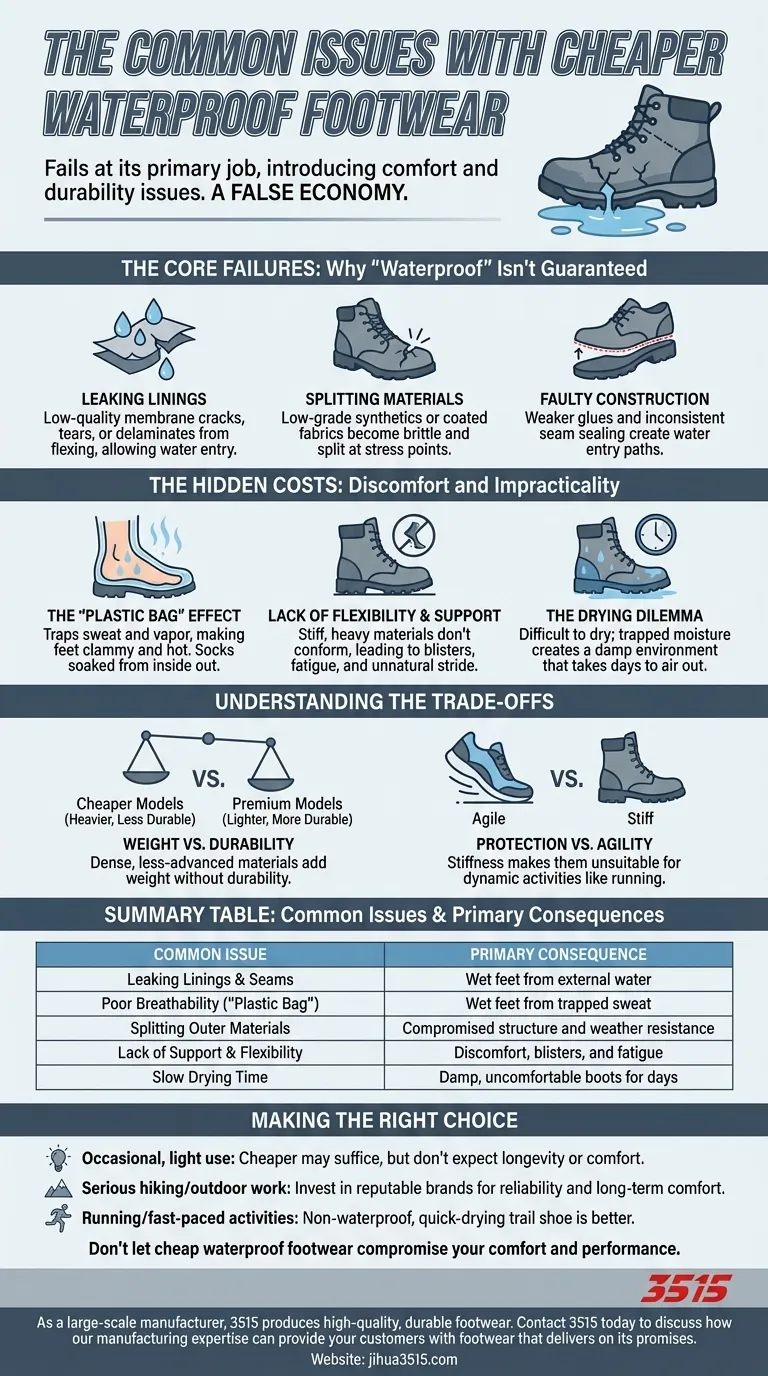To put it simply, cheaper waterproof footwear often fails at its primary job while introducing significant comfort and durability issues. Common problems include leaking liners, splitting outer materials, poor breathability that traps sweat, and a general lack of support that leads to discomfort on any extended walk.
The central issue is that inexpensive waterproof footwear creates a false economy. It attempts to solve the problem of external moisture but often creates internal moisture from sweat and fails prematurely, ultimately costing you more in discomfort and replacements.

The Core Failures: Why "Waterproof" Isn't Guaranteed
The promise of dry feet is the main selling point, but on cheaper footwear, this promise is fragile. The failure isn't just possible; it's probable, and it usually happens in one of a few key ways.
Leaking Linings
The waterproof-breathable membrane is the core technology. In budget footwear, this lining is often made from lower-quality materials that crack, tear, or delaminate from the outer fabric with repeated flexing, creating an entry point for water.
Splitting and Cracking Materials
The outer materials on cheaper boots—typically low-grade synthetics or coated fabrics—are not built for abrasion or flexing. They become brittle and split, especially at key stress points like the toe box, compromising the shoe's structure and weather resistance.
Faulty Construction
Even with a decent liner, a shoe can leak. Cheaper manufacturing often involves weaker glues and inconsistent seam sealing. This means the sole can separate or seams can fail, creating a direct path for water to enter the boot.
The Hidden Costs: Discomfort and Impracticality
Beyond outright leaking, budget waterproof footwear introduces problems that can make you wish your feet were just wet from the rain. These issues stem from the compromises made to keep costs down.
The "Plastic Bag" Effect
True waterproof-breathable membranes are a balancing act. Cheaper versions heavily favor water resistance over breathability. This traps sweat and vapor inside, making your feet feel clammy and hot. In many cases, your socks become soaked from the inside out.
Lack of Flexibility and Support
To achieve a low price point, manufacturers use stiff, heavy materials that don't conform to your foot. This leads to a clunky, unnatural stride, a lack of cushioning, and a higher likelihood of blisters and fatigue during extended use.
The Drying Dilemma
Once cheap waterproof footwear gets wet—either from a leak or from trapped sweat—it is notoriously difficult to dry. The same liner that is supposed to keep water out also traps it inside, creating a damp environment that can take days to fully air out.
Understanding the Trade-offs
All waterproof shoes involve a compromise between protection and performance. However, these trade-offs become much more severe at the lower end of the market.
Weight vs. Durability
Waterproof shoes are inherently heavier than their non-waterproof counterparts. Cheaper models amplify this by using dense, less-advanced materials to achieve water resistance, adding significant weight without offering the durability of a premium product.
Protection vs. Agility
The stiffness required to make cheap materials water-resistant makes them unsuitable for dynamic activities like running. They lack the flexibility and responsiveness needed, forcing an awkward and inefficient stride.
Making the Right Choice for Your Needs
Choosing the right footwear means matching the tool to the task. Understanding the limitations of cheaper options allows you to invest your money where it truly matters.
- If your primary focus is occasional, light use: A cheaper pair may suffice for short walks in the rain, but do not expect them to last or be comfortable for long.
- If your primary focus is serious hiking or outdoor work: Investing in a reputable brand is essential for reliability, long-term comfort, and keeping your feet dry from both rain and sweat.
- If your primary focus is running or fast-paced activities: A non-waterproof, quick-drying trail shoe is almost always a better choice than a cheap, non-breathable waterproof model.
Ultimately, your goal is to find footwear that solves your problem without creating new ones.
Summary Table:
| Common Issue | Primary Consequence |
|---|---|
| Leaking Linings & Seams | Wet feet from external water |
| Poor Breathability | Wet feet from trapped sweat (Plastic Bag Effect) |
| Splitting Outer Materials | Compromised structure and weather resistance |
| Lack of Support & Flexibility | Discomfort, blisters, and fatigue on extended walks |
| Slow Drying Time | Damp, uncomfortable boots for days after getting wet |
Don't let cheap waterproof footwear compromise your comfort and performance.
As a large-scale manufacturer, 3515 produces a comprehensive range of high-quality, durable footwear for distributors, brand owners, and bulk clients. Our production capabilities encompass all types of reliable waterproof shoes and boots designed to prevent leaks, ensure breathability, and provide lasting support.
Contact 3515 today to discuss how our manufacturing expertise can provide your customers with footwear that truly delivers on its promises.
Visual Guide

Related Products
- Safety Footwear Wholesale Manufacturer for Custom OEM/ODM Production
- Premium Flame-Retardant Waterproof Safety Boots and Shoes
- Factory Direct Wholesale Rain Boots Durable Waterproof & Fully Customizable
- Heavy-Duty Waterproof Nubuck Safety Boots Safety Shoes for Bulk Supply
- Premium KPU Injection Athletic Style Safety Shoes
People Also Ask
- Do snake bite boots work? Your Ultimate Guide to Effective Snake Bite Protection
- What cultural and environmental considerations are tied to wearing shoes indoors? Balance Hygiene, Tradition, and Foot Health
- How long can you wear safety boots? The Lifespan is Determined by Wear, Not Time
- What do heavy duty boots do? Protect Your Feet in Demanding Work Environments
- What are the cultural perspectives on wearing shoes in the house? A Guide to Home Etiquette & Hygiene



















